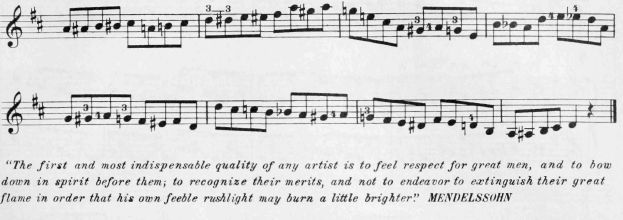Mandolin Self Instructor, online tutorial - Page 79
A simplified self learning system for the Mandolin with tuning instruction, song folio, chord diagrams, sheet music and PDF for printing. By ZARH MYRON BICKFORD
| Share page | Visit Us On FB |
|
Chromatic Study (continued) |
||
 |
||
|
Dotted Eighth Notes
The dot after an eighth note adds the value of a sixteenth note, thus being an abbreviation of
the sixteenth. This is shown in the first two measures of the first Example below, which sound and are played exactly the same. Like all tied notes, the first of the two sixteenths in the first measure is held or waited for, but not played again, the same being true of the dot in the following measure. It will be seen that the dotted eighth is exactly three times as long as the sixteenth which follows it, thus (if two be counted to the measure) using up exactly three-quarters of a beat-which is practic- ally the whole beat in a moderately quick tempo. The exact division is easy to make if the count - ing is very slow, but in quick tempos it becomes necessary to think of the dotted note, not only as the important part, but as practically the whole of the beat, connecting the sixteenth note with the following note, both mentally and actually, almost as though it were a grace note and written with the next note. This manner of picturing the sixteenth note can perhaps be illustrated as being counted- "one-- n' two—n'three—n four" as distinguished from the exact division of "one-and-two" etc. The beat itself (dotted note) must be held practically until it is time to play and count the next beat (dotted note), the sixteenth not being considered as having any time at all, although theoretically it has a quarter of the beat. A careful application of this rule will develop the style of playing which distinguishes the expert from the novice-the artist from the artisan. It should be added that the real effect of a dotted note passage in quick tempos is and usu- ally should be as though there were a rest in place of the dot, as illustrated in Example 4. |
||